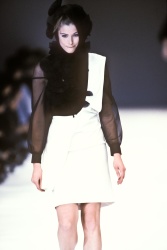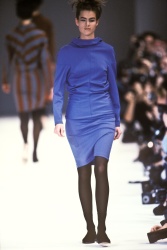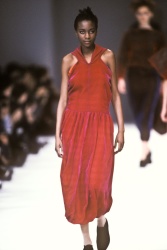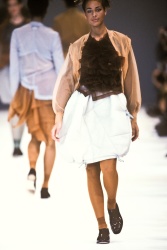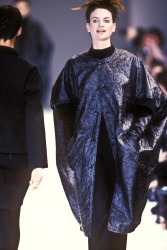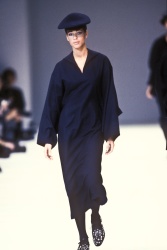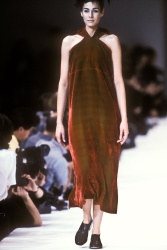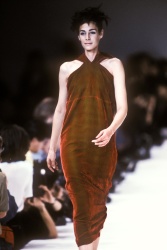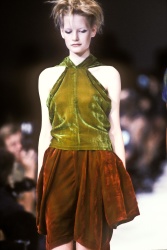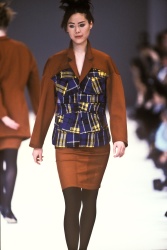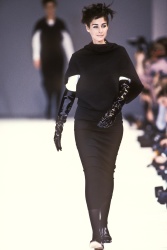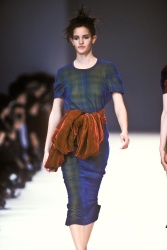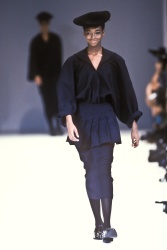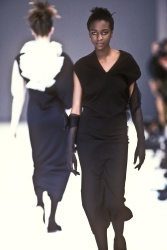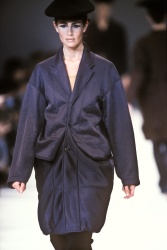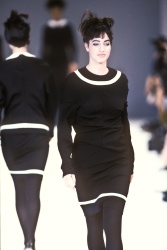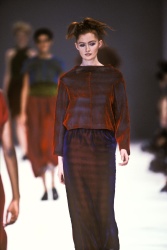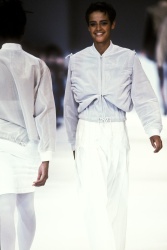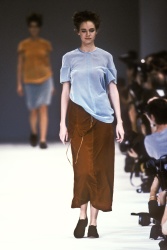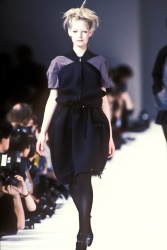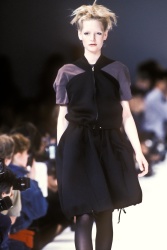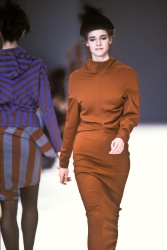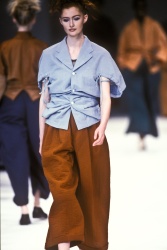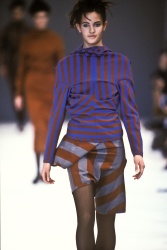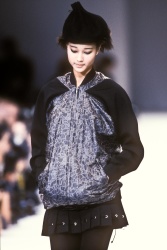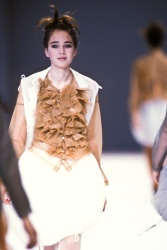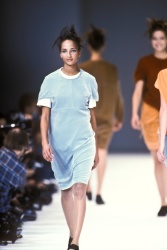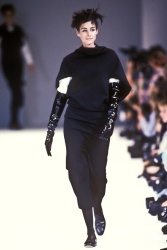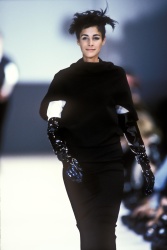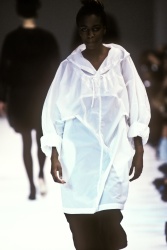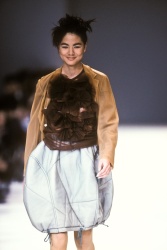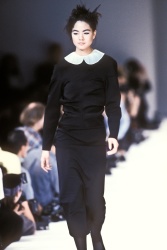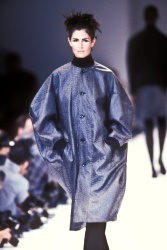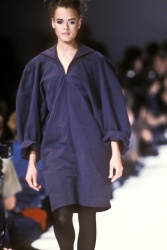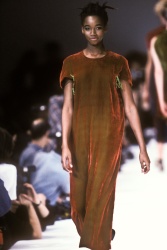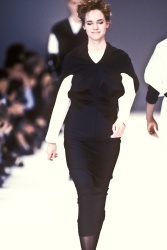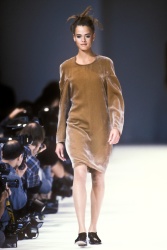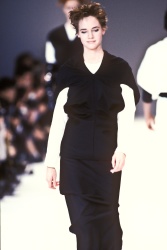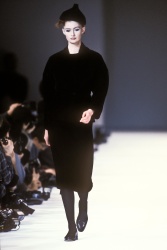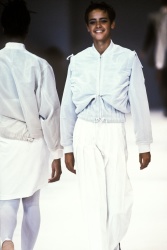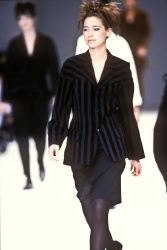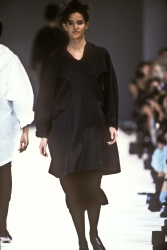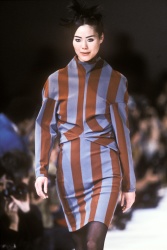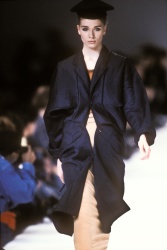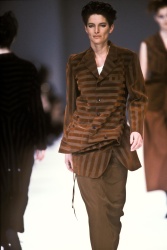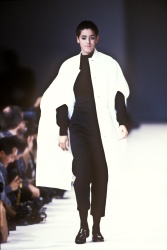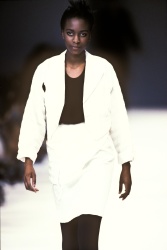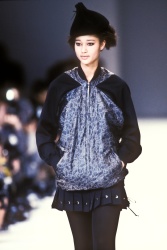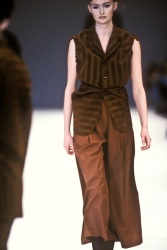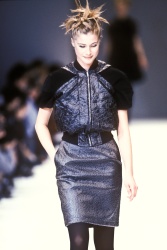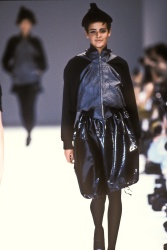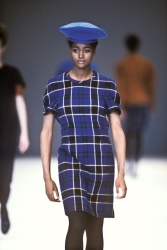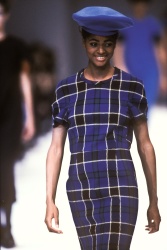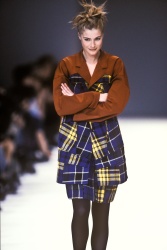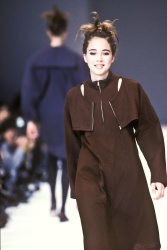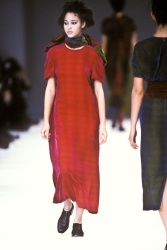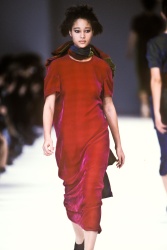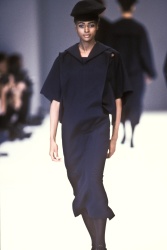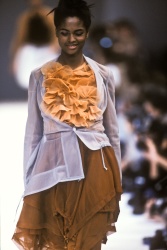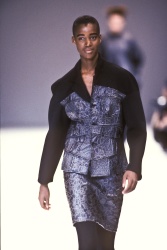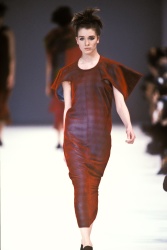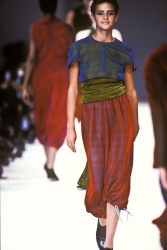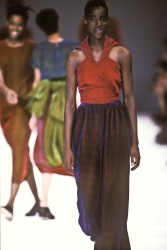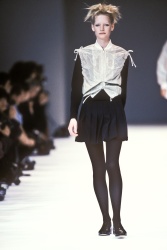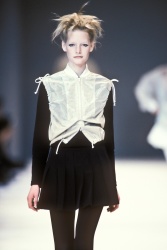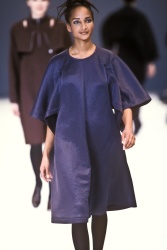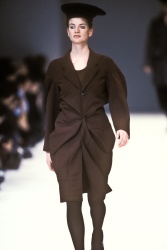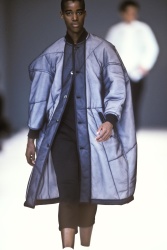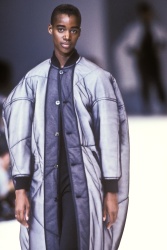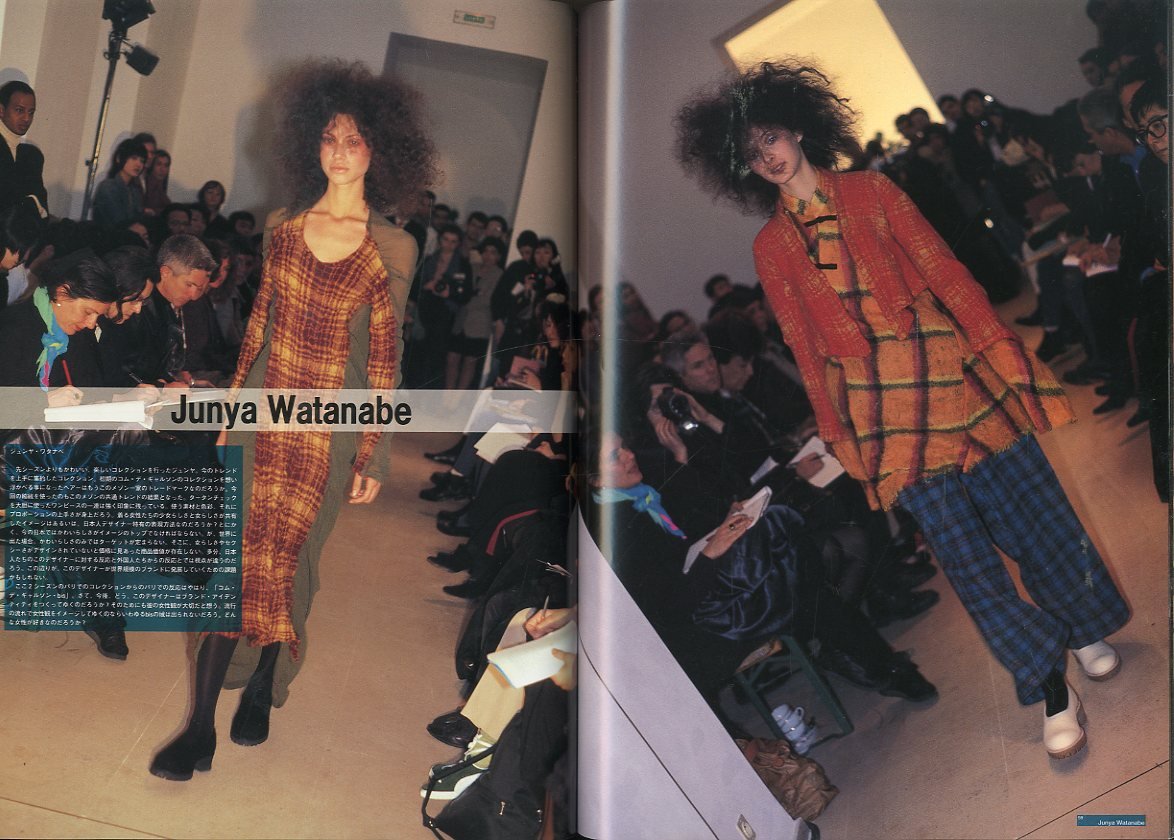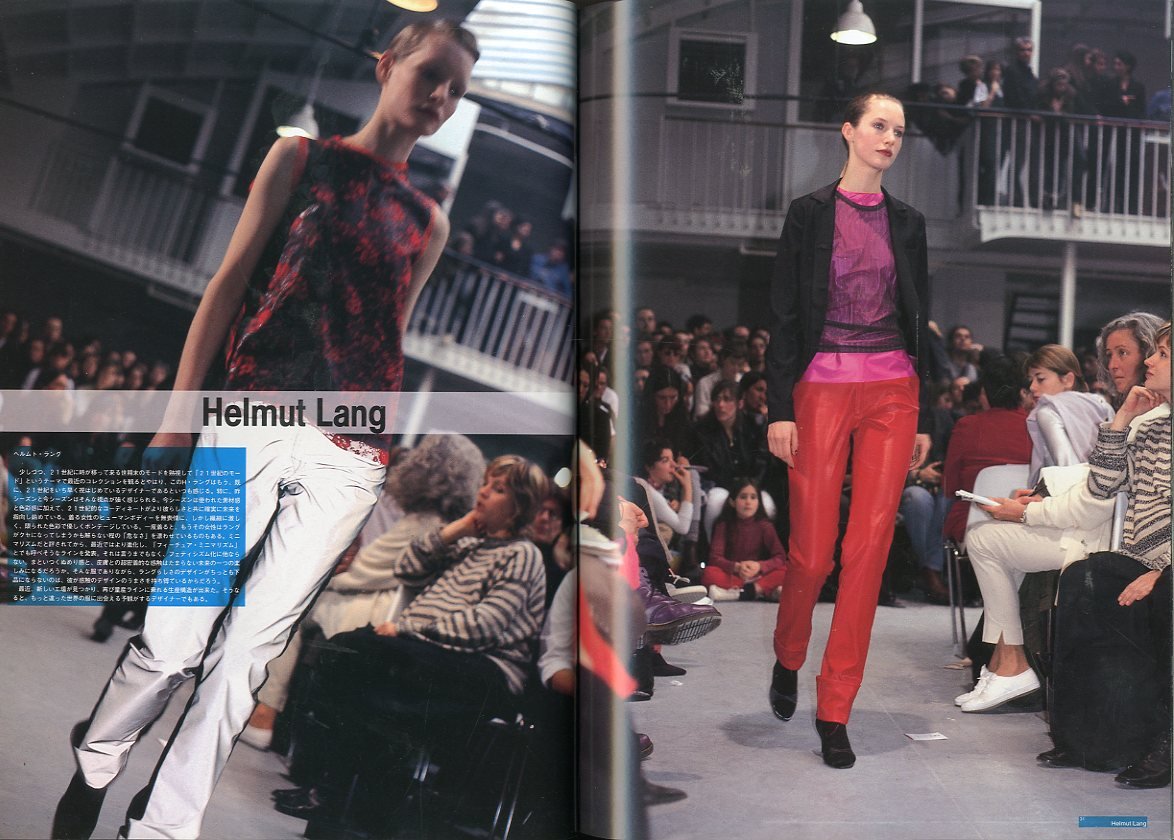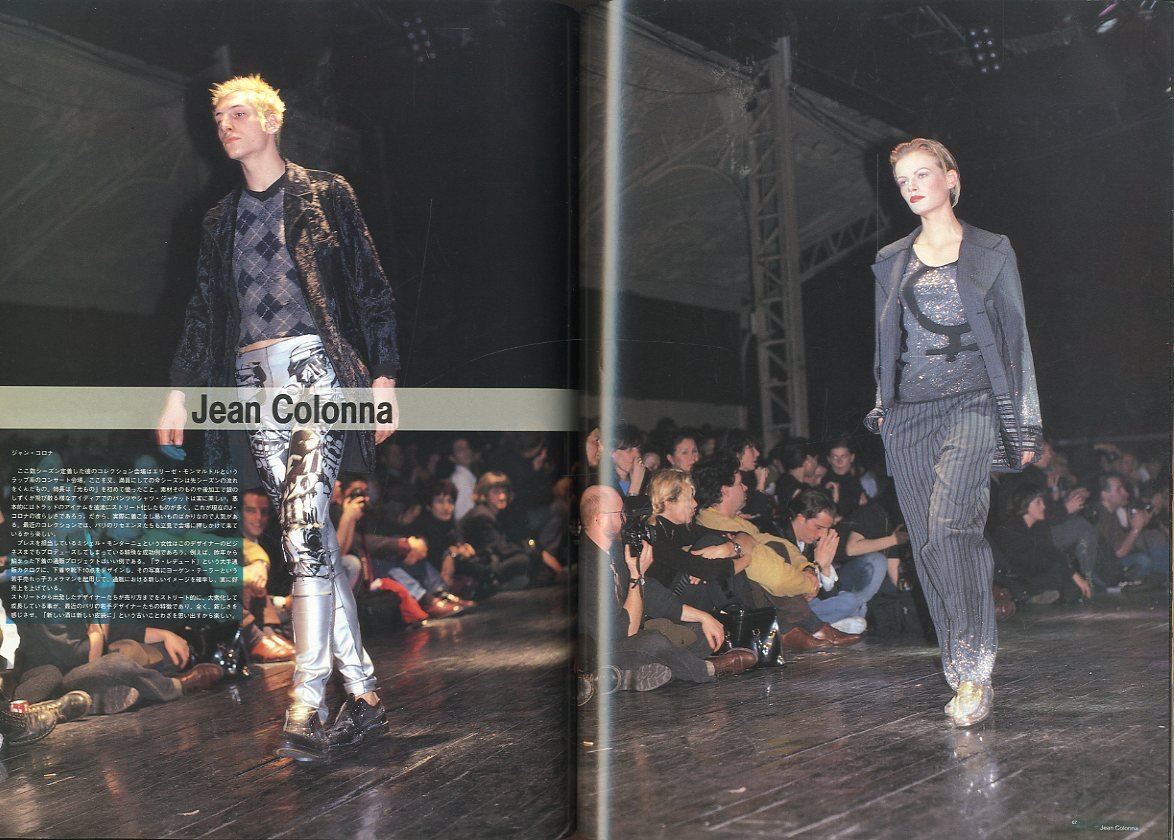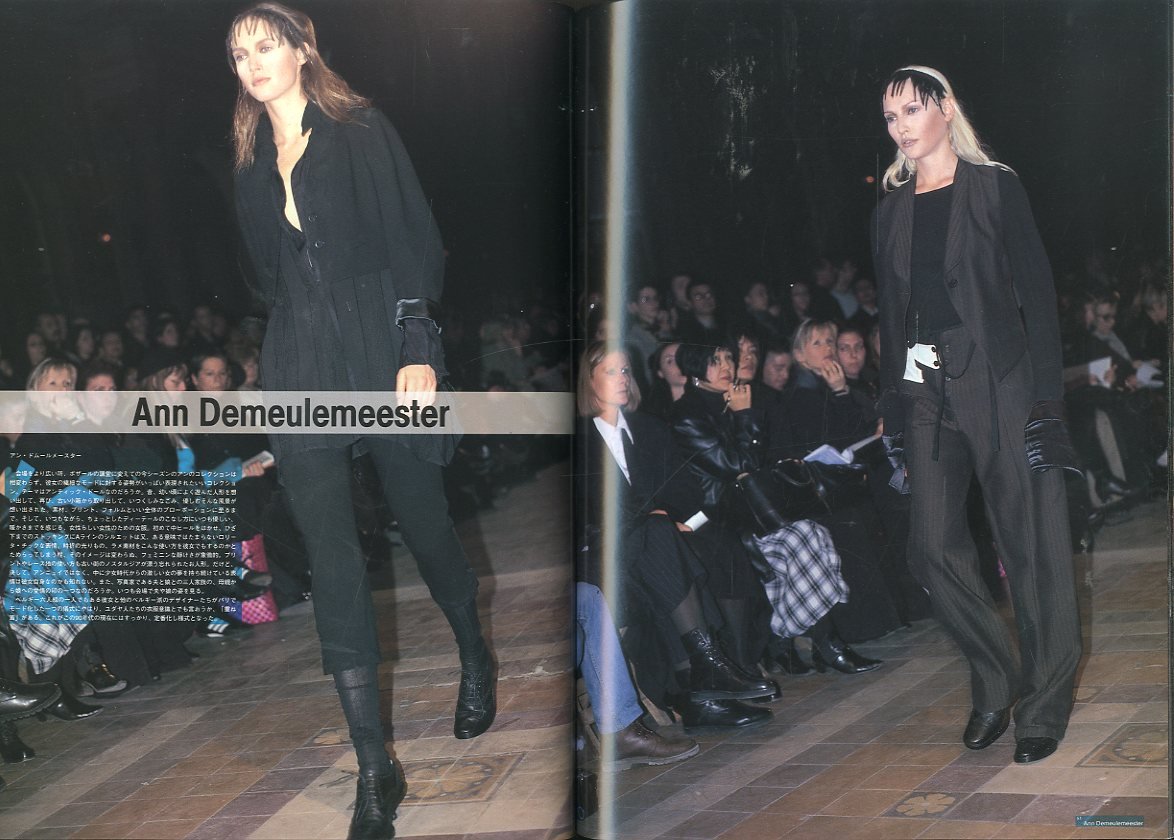-
Share with us... Your Best & Worst Collections of Haute Couture F/W 2025.26
-
Xenforo is upgrading us to version 2.3.7 on Thursday Aug 14, 2025 at 01:00 AM BST. This upgrade includes several security fixes among other improvements. Expect a temporary downtime during this process. More info here
You are using an out of date browser. It may not display this or other websites correctly.
You should upgrade or use an alternative browser.
You should upgrade or use an alternative browser.
Comme des Garçons F/W 1990.91 Paris
- Thread starter Maayan
- Start date
MulletProof
Well-Known Member
- Joined
- Apr 18, 2004
- Messages
- 28,790
- Reaction score
- 7,546
Loved how these smaller pieces (the hats, the pleated miniskirts, leather gloves) used to bring a fun side to these collections, the Nike/CDG logos and sneakers seems to have that role now, with a poor performance.
I'm kind of more intrigued about 80s shows now.. there seems to be a big shift in terms of casting/presentation right around this time (Fall 1990-Spring 1992) and the women modeling in these shows completely change and become more interchangeable and uniformed in terms of race, body type, age, demeanor (you go from full teeth smiles and crossed arms to reducing anything that could potentially steal attention from the clothes). Was this change happening everywhere, not just at CDG, or did they go through some change of direction or brand transformation?.. @runner (casually looping you in for any info/wild guess you may have!).
I'm kind of more intrigued about 80s shows now.. there seems to be a big shift in terms of casting/presentation right around this time (Fall 1990-Spring 1992) and the women modeling in these shows completely change and become more interchangeable and uniformed in terms of race, body type, age, demeanor (you go from full teeth smiles and crossed arms to reducing anything that could potentially steal attention from the clothes). Was this change happening everywhere, not just at CDG, or did they go through some change of direction or brand transformation?.. @runner (casually looping you in for any info/wild guess you may have!).
runner
.
- Joined
- Feb 26, 2004
- Messages
- 12,842
- Reaction score
- 1,465
^ just some facts around that time you could factor in.
1992 was the year she married adrian joffe. that is, the start of what is called (by me though) adrian effect,
which led them to immediately entering perfume market, eventually promoting the streamlining, etc.
and of course it's not like she married him on the day she first met him.
before that, her fashion coconspirator had been yohji, since the 70's.
there had been a designer brands boom (at least in japan). from armani, rykiel, versace, etc, to gaultier and crows like rei, yohji.
but in very late 80'S and early 90'S, it was being declining as a reaction.
sort of "authentic" (or uniformed, in a way) labels such as levis (vintage 501's specifically), red wing, pendleton, etc took the place of it.
it was the gloomy age of designers fashion. but they must have leaned some things from it. collabos with those labels etc.
grunge in, happy fun fashion out.
people feeling party's over. mostly sparse festive mood.
jean touitou (A.P.C.), jean colonna, margiela, lang were some of those who were sirently making the audience heads turn to designers fashion again.
so here is my guess.
it was one of critical turning points in the comme history which was being overlapped with sign of the times.
or sign of the times led her to marriage.
1992 was the year she married adrian joffe. that is, the start of what is called (by me though) adrian effect,
which led them to immediately entering perfume market, eventually promoting the streamlining, etc.
and of course it's not like she married him on the day she first met him.
before that, her fashion coconspirator had been yohji, since the 70's.
there had been a designer brands boom (at least in japan). from armani, rykiel, versace, etc, to gaultier and crows like rei, yohji.
but in very late 80'S and early 90'S, it was being declining as a reaction.
sort of "authentic" (or uniformed, in a way) labels such as levis (vintage 501's specifically), red wing, pendleton, etc took the place of it.
it was the gloomy age of designers fashion. but they must have leaned some things from it. collabos with those labels etc.
grunge in, happy fun fashion out.
people feeling party's over. mostly sparse festive mood.
jean touitou (A.P.C.), jean colonna, margiela, lang were some of those who were sirently making the audience heads turn to designers fashion again.
so here is my guess.
it was one of critical turning points in the comme history which was being overlapped with sign of the times.
or sign of the times led her to marriage.
MulletProof
Well-Known Member
- Joined
- Apr 18, 2004
- Messages
- 28,790
- Reaction score
- 7,546
^ ahh thank you! I KNEW there was something critical in that small gap of time. She's a Libra (lol), they walk into relationships like it's a cult!. So they get married that year, but he also becomes the president of her company in that same year? *sighs*. I definitely see the general spirit of the times weighing in, but also something more personal or just in terms of brand philosophy, and the 'Adrian effect' as you call it makes perfect sense.. how long did they date before they got married? and when did she and Yohji break up? (sounds like they were still together up until 1990..?, if that was the case, well played, Adrian!  ). The designs were obviously not compromised (more like the opposite!) but you definitely see the brand becoming super Eurocentric and just.. I don't know, vanilla/watered down/translated-for-the-West in terms of presentation.
). The designs were obviously not compromised (more like the opposite!) but you definitely see the brand becoming super Eurocentric and just.. I don't know, vanilla/watered down/translated-for-the-West in terms of presentation.
 ). The designs were obviously not compromised (more like the opposite!) but you definitely see the brand becoming super Eurocentric and just.. I don't know, vanilla/watered down/translated-for-the-West in terms of presentation.
). The designs were obviously not compromised (more like the opposite!) but you definitely see the brand becoming super Eurocentric and just.. I don't know, vanilla/watered down/translated-for-the-West in terms of presentation.runner
.
- Joined
- Feb 26, 2004
- Messages
- 12,842
- Reaction score
- 1,465
^ some say it was not until the 80's ended that rei and adrian started dating. but I don't know anything about it myself.
it seems that 1987 was when adrian joined CdG paris as a commercial director (homme plus, specifically). he quit the job once, to start a new one at club med.
and at the request from rei , he returned in 1992.
although I don't know how many starting over's yohji and rei had had, YY and CdG were the buddy system. for example, in the 70's they decided together how their clothes should appear in magazines, which magazine it should be, etc.
the same textile designer (hiroshi matsushita) was working exclusively for them.
as you suggest, in tokyo their collections ( FW1991 june pour homme and homme plus) were shown jointly on the same runway. (I'm not sure if yohji fought lightly with john lurie who was there as a model because he was being a bit uptight due to adrian thing. and yes you can tell they are thinking they are in a crisis if they are back and show their presence in tokyo, like FW1994 april CdG/homme plus joint show, FW2010 april pour homme, etc. also in the midst of the pandemic rei appeared in three news programs and had interviews. what she had never done before.)
and according to yohji himself his debut in paris was like this:
"The store opened in April 1981, and all of the products were exported from Japan.
Our arrival in Paris was a great opportunity, so we decided to hold a floor show as well. For my part, I wanted Rei Kawakubo of Comme des Garçons to go together to Paris at around the same time. Since Y's and Comme des Garçons were both considered avant-garde, I thought it would be more effective to collaborate for our debut in Paris, just as we had done in Japan.
But I did not know what Kawakubo's intentions were. She may have been thinking it was too early to make her debut in Paris.
In any event, I decided to move ahead alone. I followed the advance team and began to prepare the store and show. I never dreamed that our Paris debut would later become a major event that would shake the entire world of fashion.
As I was preparing for my prêt-à-porter debut in Paris in April 1981, I decided to ensure that the collection would be devoid of any taste or flavor of Japanese culture. I was determined not to use any element Japanese fashion designers tended to use casually in their clothes, such as straight-line cutting and kimono patterns.
A "nonconformist," I was loath to do anything designed to go down well with foreigners. I only used European-style structural designs and cuts, adopting vinyl and urethane as their materials.
Since I had not yet built a working relationship with overseas media nor issued any media announcement about my Paris debut, I did not expect my show to attract a large audience. But some buyers dropped in to see the collection. One of them was Barbara Weiser, the daughter of Selma Weiser, who founded Charivari, a fashion boutique in New York. She told me that Comme des Garçons' Rei Kawakubo was also staging a show at a different venue in Paris.
The news surprised me and lifted my spirits.
My guess is that Kawakubo made a sudden decision to debut her collection in Paris and staged her show with a flurry of activity. It was a coincidence that Kawakubo and I burst onto the Paris fashion scene at the same time, but our unintentionally synchronized foray into the French capital had a huge impact on the world of fashion. Our collections attracted a lot of media attention."
"It is strange, but from the moment I first saw the clothes of Comme des Garçons, I felt they had a common aesthetic and philosophy with Y's. On the sales floor, the tasteful clothes as if they had been carefully stored in a wicker drawer were lined up randomly.
Kawakubo's sensibility was close to my own in terms of use of color and materials. Or rather, I thought hers might be stronger and clearer than my own.
As a result, Y's and Comme des Garçons were grouped together in the "avant-garde" genre and often opened stores next to each other. From the perspective of a distributor choosing brands, this would probably have a greater impact on the store's sales strategy."
from nikkei
it seems that 1987 was when adrian joined CdG paris as a commercial director (homme plus, specifically). he quit the job once, to start a new one at club med.
and at the request from rei , he returned in 1992.
although I don't know how many starting over's yohji and rei had had, YY and CdG were the buddy system. for example, in the 70's they decided together how their clothes should appear in magazines, which magazine it should be, etc.
the same textile designer (hiroshi matsushita) was working exclusively for them.
as you suggest, in tokyo their collections ( FW1991 june pour homme and homme plus) were shown jointly on the same runway. (I'm not sure if yohji fought lightly with john lurie who was there as a model because he was being a bit uptight due to adrian thing. and yes you can tell they are thinking they are in a crisis if they are back and show their presence in tokyo, like FW1994 april CdG/homme plus joint show, FW2010 april pour homme, etc. also in the midst of the pandemic rei appeared in three news programs and had interviews. what she had never done before.)
and according to yohji himself his debut in paris was like this:
"The store opened in April 1981, and all of the products were exported from Japan.
Our arrival in Paris was a great opportunity, so we decided to hold a floor show as well. For my part, I wanted Rei Kawakubo of Comme des Garçons to go together to Paris at around the same time. Since Y's and Comme des Garçons were both considered avant-garde, I thought it would be more effective to collaborate for our debut in Paris, just as we had done in Japan.
But I did not know what Kawakubo's intentions were. She may have been thinking it was too early to make her debut in Paris.
In any event, I decided to move ahead alone. I followed the advance team and began to prepare the store and show. I never dreamed that our Paris debut would later become a major event that would shake the entire world of fashion.
As I was preparing for my prêt-à-porter debut in Paris in April 1981, I decided to ensure that the collection would be devoid of any taste or flavor of Japanese culture. I was determined not to use any element Japanese fashion designers tended to use casually in their clothes, such as straight-line cutting and kimono patterns.
A "nonconformist," I was loath to do anything designed to go down well with foreigners. I only used European-style structural designs and cuts, adopting vinyl and urethane as their materials.
Since I had not yet built a working relationship with overseas media nor issued any media announcement about my Paris debut, I did not expect my show to attract a large audience. But some buyers dropped in to see the collection. One of them was Barbara Weiser, the daughter of Selma Weiser, who founded Charivari, a fashion boutique in New York. She told me that Comme des Garçons' Rei Kawakubo was also staging a show at a different venue in Paris.
The news surprised me and lifted my spirits.
My guess is that Kawakubo made a sudden decision to debut her collection in Paris and staged her show with a flurry of activity. It was a coincidence that Kawakubo and I burst onto the Paris fashion scene at the same time, but our unintentionally synchronized foray into the French capital had a huge impact on the world of fashion. Our collections attracted a lot of media attention."
"It is strange, but from the moment I first saw the clothes of Comme des Garçons, I felt they had a common aesthetic and philosophy with Y's. On the sales floor, the tasteful clothes as if they had been carefully stored in a wicker drawer were lined up randomly.
Kawakubo's sensibility was close to my own in terms of use of color and materials. Or rather, I thought hers might be stronger and clearer than my own.
As a result, Y's and Comme des Garçons were grouped together in the "avant-garde" genre and often opened stores next to each other. From the perspective of a distributor choosing brands, this would probably have a greater impact on the store's sales strategy."
from nikkei
runner
.
- Joined
- Feb 26, 2004
- Messages
- 12,842
- Reaction score
- 1,465
btw, this was happening simultaneously. the current was layered and a bit complicated.
junya had been a chief designer at tricot since 1987.
in the autumn of 1991 he made a direct appeal to rei for something more creative.
designers fashion industry was officially in recession. I guess designs tended to have to be safer. tricot was a line that had to sell steadily.
and rei allowed him to do what he simply wanted to. this is how "junya watanabe" began.
FW1992 the first collection.
names who made the audience want to wear designers' clothes again include junya.
then rei, stimulated by junya, took the risk and presented the FW1994 collections (comme and homme plus).
they say she prepared for bankruptcy. though it turned out to be one of the biggest hits.
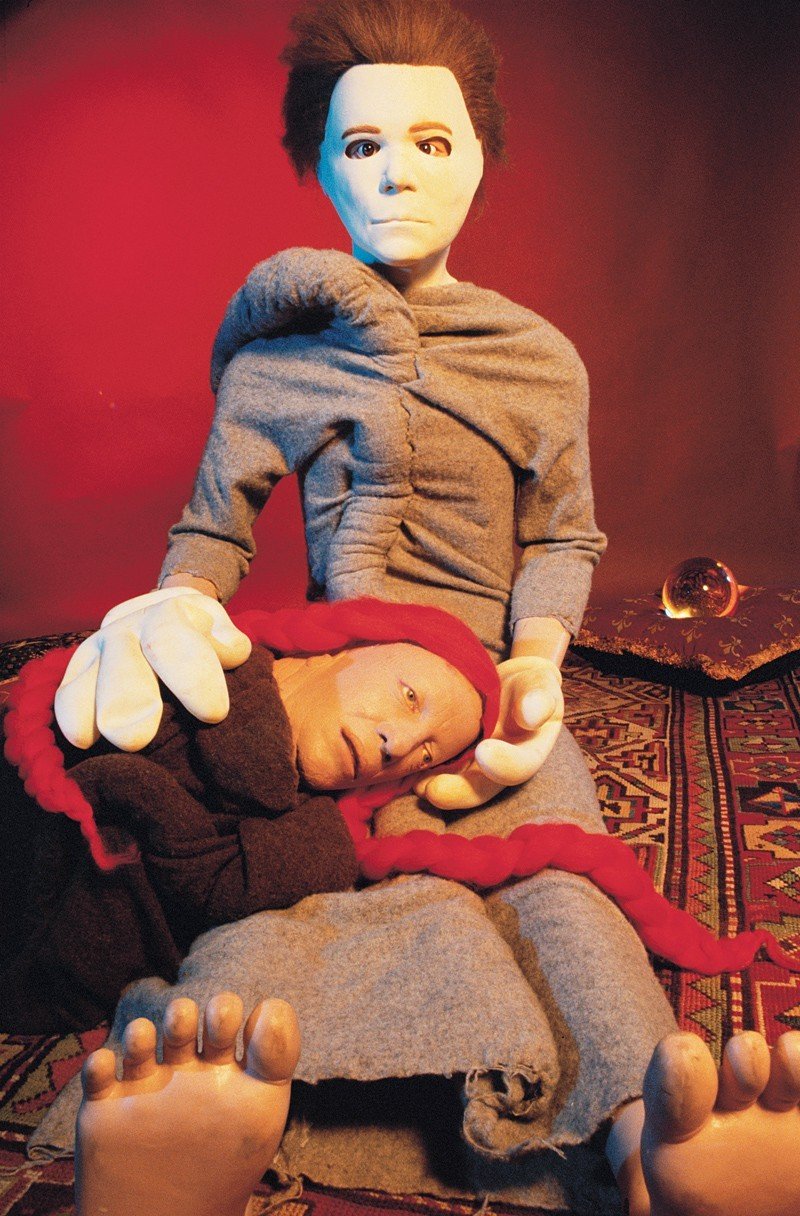
vlr.eng
junya had been a chief designer at tricot since 1987.
in the autumn of 1991 he made a direct appeal to rei for something more creative.
designers fashion industry was officially in recession. I guess designs tended to have to be safer. tricot was a line that had to sell steadily.
and rei allowed him to do what he simply wanted to. this is how "junya watanabe" began.
FW1992 the first collection.
names who made the audience want to wear designers' clothes again include junya.
then rei, stimulated by junya, took the risk and presented the FW1994 collections (comme and homme plus).
they say she prepared for bankruptcy. though it turned out to be one of the biggest hits.

vlr.eng
MulletProof
Well-Known Member
- Joined
- Apr 18, 2004
- Messages
- 28,790
- Reaction score
- 7,546
^ great crash course as always, runner! thank you so much. 
I remember reading some of this when I was a teenager (probably also shared by you!) and like most things I read/liked/heard then, they just sound sooo different now, I think I notice more layers and instead of just taking it in as I used to, now I just have more questions or plain curiosity. It's kind of amazing they were pushing 40 by the time they revolutionized fashion.. and kind of odd that their Paris debut was a coincidence... how? did they date after that then? or were they just ultra protective/competitive?
Also loved that bit on nonconformism.. funny how in an effort to escape clichés and others' interpretation of your background, the idea of experimentation and even just subversiveness (which is also informed by cultural/social elements) sometimes ends up saying more about the 'foreign' land you come from than not bothering to mention it at all.
What is the photo in #8? the very beginning and before the show [post 9])? so Junya, very early 90s humor too.

I remember reading some of this when I was a teenager (probably also shared by you!) and like most things I read/liked/heard then, they just sound sooo different now, I think I notice more layers and instead of just taking it in as I used to, now I just have more questions or plain curiosity. It's kind of amazing they were pushing 40 by the time they revolutionized fashion.. and kind of odd that their Paris debut was a coincidence... how? did they date after that then? or were they just ultra protective/competitive?
Also loved that bit on nonconformism.. funny how in an effort to escape clichés and others' interpretation of your background, the idea of experimentation and even just subversiveness (which is also informed by cultural/social elements) sometimes ends up saying more about the 'foreign' land you come from than not bothering to mention it at all.

What is the photo in #8? the very beginning and before the show [post 9])? so Junya, very early 90s humor too.
these are miles better than anything I’ve seen last season or even the last 5 years. The mere concept of Avant-garde now seems a distant dream, gone foreverjust for reference
View attachment 1238523
View attachment 1238524
View attachment 1238525
View attachment 1238526
nitesha
runner
.
- Joined
- Feb 26, 2004
- Messages
- 12,842
- Reaction score
- 1,465
and kind of odd that their Paris debut was a coincidence... how? did they date after that then? or were they just ultra protective/competitive?
"an English translation of a 29-part series of Nikkei's "My Personal History" ("Watashi no Rirekisho"); the Japanese series was published in September 2021."
from nikkei
so, that is an english translation of what yohji originally wrote in japanese for nikkei.
I just checked and found it's a mistranslation. I don't know why it wound up mistranslated all the way like that.
the translation
"It was a coincidence that Kawakubo and I burst onto the Paris fashion scene at the same time, but our unintentionally synchronized foray into the French capital had a huge impact on the world of fashion. "
the original
とにかく結果として、私と川久保さんが同じタイミングでパリに出たことはモード業界に対する強烈なインパクトになった。
if you translate faithfully, it should be:
"anyway, as a result, mrs. kawakubo and I debuting in paris simultaneously had a huge impact on fashion industry."
I think yohji had to write about that there because the description of their paris debut by takeji hirakawa sounds as if in the late 70's they had made plans for the dream of paris in their pillow talk. maybe yohji wanted to say the relationship was not that clingy.
while yohji might have a big mouth, rei could have "if you care, don't let them know. don't give yourself away" kind of style.
and, as you say, it seemed to be competitive sometimes.
in fact, nobuyuki ota (former CEO of issey miyake and above-mentioned matsushita's relative) witnessed that in paris rei had got cross, seeing the new gabardine that appeared around the finale of YY show, like why is that fabric in his hands instead of mine??
then he saw matsushita being complained to.
MulletProof
Well-Known Member
- Joined
- Apr 18, 2004
- Messages
- 28,790
- Reaction score
- 7,546
why is that fabric in his hands instead of mine??
 .. yeah that's why I could never date someone in the exact same field. How exhausting to pretend I'm 'SO happy!' for them when more often than not, my brain understands someone's triumph as my own defeat lol.
.. yeah that's why I could never date someone in the exact same field. How exhausting to pretend I'm 'SO happy!' for them when more often than not, my brain understands someone's triumph as my own defeat lol.You just reminded me I need to catch up with Nikkei's series!
 . Wonder why he feels the need to readdress it, who cares if it was pillow talk.. that makes more sense than a coincidence on two huge and similar professional ventures, as foreigners.. with your own partner!
. Wonder why he feels the need to readdress it, who cares if it was pillow talk.. that makes more sense than a coincidence on two huge and similar professional ventures, as foreigners.. with your own partner!runner
.
- Joined
- Feb 26, 2004
- Messages
- 12,842
- Reaction score
- 1,465
Also loved that bit on nonconformism.. funny how in an effort to escape clichés and others' interpretation of your background, the idea of experimentation and even just subversiveness (which is also informed by cultural/social elements) sometimes ends up saying more about the 'foreign' land you come from than not bothering to mention it at all.
What is the photo in #8? the very beginning and before the show [post 9])? so Junya, very early 90s humor too.
the translation
"A "nonconformist," I was loath to do anything designed to go down well with foreigners."
the original
「へそ曲がり」なので外国人に受けそうなことはあえてしたくなかったからだ。
a faithful translation would be:
"that's because, being a "twisted person," I clearly knew that I didn't want to do things that were likely to go down well with people from other countries."
even if you try to get rid of the smell of your culture, your way of erasing it betrays your roots.
even if you reject self-expression, yourself shows up in your style of rejection.
maybe its destruction is harder than its expression. but that's alright. the heart of yohji lies in negation.
it's black, crossed out with infinite strikethrough.
the image is from the ad campaign for comme and homme plus FW1994 by cindy sherman.
back then it came in postcard, poster, etc.
runner
.
- Joined
- Feb 26, 2004
- Messages
- 12,842
- Reaction score
- 1,465
btw, rei and yohji are both graduates of keio university. though what they majored in were different and thefore probably they were not acquainted with each other there yet.
also they attended setsu mode seminar (sort of legendary art school, training hall) when they were much younger (yohji wanted to be a painter in his high school days). though they went there in totally different periods.
the latter is not directly related to fashion. the former has nothing to do with fashion.
contingency did seem to be wafting around them, as if it had wanted a chance encounter to take place.
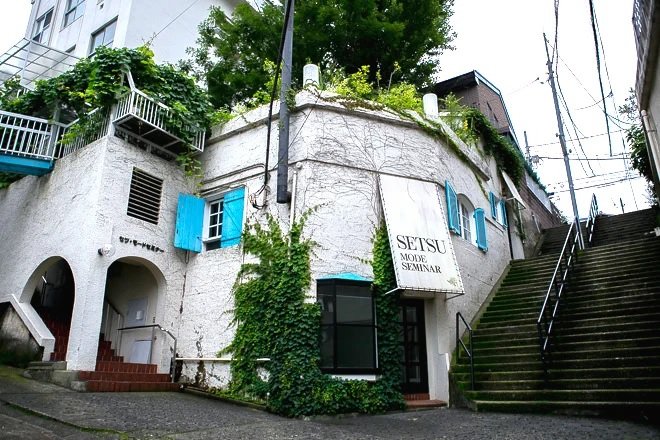
rei and yohji in the setsu alumni group pic
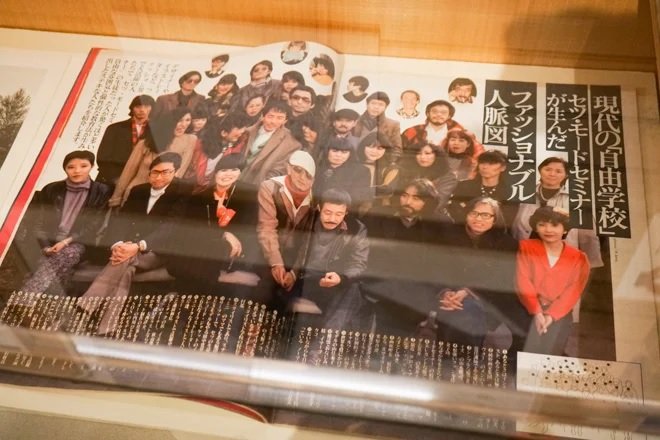
fashionsnap
also they attended setsu mode seminar (sort of legendary art school, training hall) when they were much younger (yohji wanted to be a painter in his high school days). though they went there in totally different periods.
the latter is not directly related to fashion. the former has nothing to do with fashion.
contingency did seem to be wafting around them, as if it had wanted a chance encounter to take place.

rei and yohji in the setsu alumni group pic

fashionsnap
MulletProof
Well-Known Member
- Joined
- Apr 18, 2004
- Messages
- 28,790
- Reaction score
- 7,546
^ Rei's the one with the necklace, correct? looking positively thrilled with those crossed arms. 
I'm not really that much of a romantic but I do think life is... one magnetic field where our understanding of time/phases is meaningless .. you don't quite synch with a person/situation in x time but eventually the right amount of energy will bring you closer. I wonder if these two keep in touch... since they're older and wiser now! or maybe.. being both Air signs (lol) once they truly move on, it's like they never happened.
.. you don't quite synch with a person/situation in x time but eventually the right amount of energy will bring you closer. I wonder if these two keep in touch... since they're older and wiser now! or maybe.. being both Air signs (lol) once they truly move on, it's like they never happened.

I'm not really that much of a romantic but I do think life is... one magnetic field where our understanding of time/phases is meaningless
 .. you don't quite synch with a person/situation in x time but eventually the right amount of energy will bring you closer. I wonder if these two keep in touch... since they're older and wiser now! or maybe.. being both Air signs (lol) once they truly move on, it's like they never happened.
.. you don't quite synch with a person/situation in x time but eventually the right amount of energy will bring you closer. I wonder if these two keep in touch... since they're older and wiser now! or maybe.. being both Air signs (lol) once they truly move on, it's like they never happened.runner
.
- Joined
- Feb 26, 2004
- Messages
- 12,842
- Reaction score
- 1,465
mullet, more details told by himself, if you are interested.
"And then I started to talk to Rei Kawakubo [when] I was invited to open a store at Seibu department store. Yohji Yamamoto and Comme des Garçons were neighbors. That was the first time we met. And after finishing the [set-up], I asked her how she would get back and she said she was in Aoyama, which is located between Seibu in Shibuya and my office, so naturally I said I would [drop] her off.
[Our relationship] started from that point, we were together for five years — good memories and at the same time, bad memories.........."
"And then I started to talk to Rei Kawakubo [when] I was invited to open a store at Seibu department store. Yohji Yamamoto and Comme des Garçons were neighbors. That was the first time we met. And after finishing the [set-up], I asked her how she would get back and she said she was in Aoyama, which is located between Seibu in Shibuya and my office, so naturally I said I would [drop] her off.
[Our relationship] started from that point, we were together for five years — good memories and at the same time, bad memories.........."
MulletProof
Well-Known Member
- Joined
- Apr 18, 2004
- Messages
- 28,790
- Reaction score
- 7,546
^ that kind of answers my question from 2023 and they most likely do not really keep in touch.
Thank you!
Thank you!
Similar Threads
- Replies
- 11
- Views
- 4K
- Replies
- 17
- Views
- 7K
- Replies
- 43
- Views
- 7K
- Replies
- 32
- Views
- 17K
- Replies
- 19
- Views
- 6K
Users who are viewing this thread
Total: 1 (members: 0, guests: 1)

